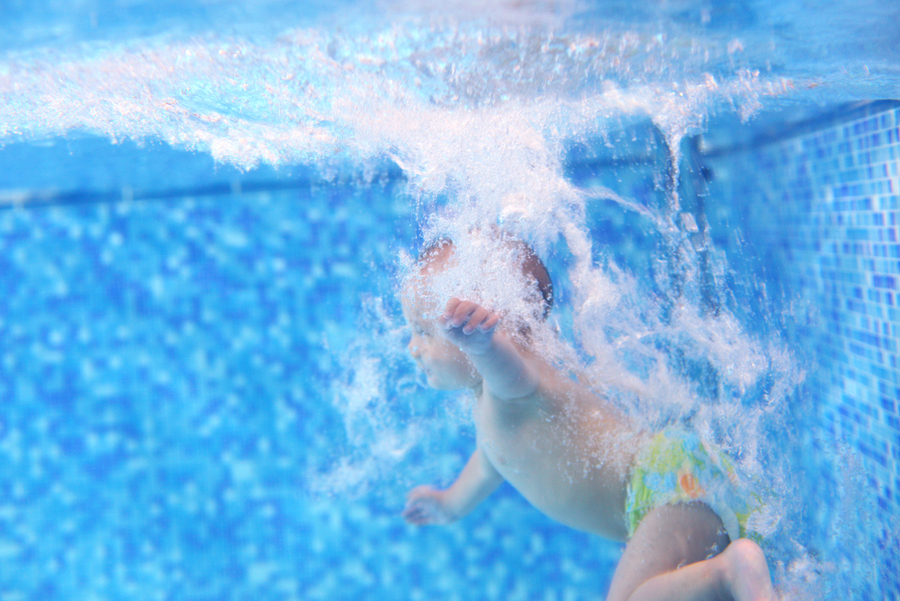10 Child Swimming Pool Accident Statistics Every Florida Parent Needs To Know

National Water Safety Month, 1/4
Note: This blog is the first of four installments regarding National Water Safety Month. In this series, our law firm shares tips on how Florida residents or visitors can keep themselves safe around the water and what steps they can take if they’ve been injured in a water-related accident. Today’s blog deals with child swimming pool accidents and what Florida parents need to know./p>
May is National Water Safety Month. This month received this designation because in most of the country, summer is around the corner and people are just about to start interacting with the water again (jumping in the pool, going to the beach, getting on their boat, etc.) While Florida weather is much warmer year-round than the rest of the country, May still marks a change in the water temperatures, and during the next few summer months, more people in Florida will be spending their recreational time in swimming pools.
Because Florida has the most swimming pools – data from 2000 showed that there were approximately 1.1 million total residential swimming pools in the Sunshine State, and that number has likely increased substantially in the last 21 years – it is important for Florida parents to understand that swimming pools pose inherent dangers to children, and take the steps necessary to protect them from potential swimming pool accidents, injuries, and death.
Knowledge is power! Swimming pools are commonly seen only as sources of fun and a way to entertain children; simply realizing that swimming pools can be very dangerous can heighten your personal awareness and keep your children safe from these tragic accidents. To that end, here are 10 child swimming pool accident statistics and facts that every Florida parent needs to know.
-
-
Florida has the highest drowning death rate in the nation for children under age 5.
Because the weather is warmer in Florida year-round and gets extremely hot for many months, there are more swimming pools in this state than nearly any other, and because we are surrounded by ocean, the risk of younger children drowning is higher in this state. Tragically, there are enough children under the age of 5 who die by drowning every year to fill 3-4 preschool classrooms (67 in 2017, 74 in 2018, and 50 in 2019).
From 2017-2019, Florida was ranked the highest in the nation for unintentional drowning for kids ages 1-4, according to the CDC. With an age-adjusted rate, Florida ranked 6th in the U.S. behind Hawaii, Alaska, Mississippi, Montana, and Louisiana for children of all ages.
-
Drowning is the number one cause of unintentional death for children between the ages of 1 and 14, and the second leading cause of death among children ages 1-4.
Unfortunately, drowning is such a common occurrence that it is actually the second leading killer of children under the age of 5. Children are more likely to drown than adults simply because most of them, when they are this young, aren’t strong swimmers, may wander away from parents’ watchful eyes, and don’t have the strength to pull themselves out of the water if something goes wrong.
-
77 percent of children involved in a residential drowning accident had been missing for no more than five minutes when they were found in the swimming pool—and nearly 70 percent weren’t expected to be in or near the pool at that time.
One of the common myths about drowning is that it takes a long time or is going to be predictable, when that could not be farther from the truth. Even letting your kid out of your sight when a pool is accessible nearby for a minute can result in a scary or fatal swimming pool accident. Overwhelmingly, data shows that children who drown weren’t even supposed to be near a pool, and hadn’t been out of their parents’ sight for very long.
-
Drowning is silent, and can happen in a matter of seconds.
In movies, drowning is usually accompanied by a loud struggle, splashing, and cries for help, but this is faked for dramatic purposes, and child drowning (indeed, drowning in general) looks and sounds nothing like that. Drowning is a silent, quick killer. Drowning victims will extend their arms laterally to try to breathe, instead of waving for help, and they keep their mouth at water level to try to take in air. Young children actually have a diving reflex, where they will be naturally inclined to hold their breath and sink if they fall in the water. Children drowning have anywhere from 20 to 60 seconds before they’ll be completely under the water and unseen.
-
African-American male children are more likely than other children to drown.
There are definitely racial disparities present in drowning statistics. Theories behind this disparity include a lack of access to lessons and a history of segregation. The USA Swimming Foundation reported that 64% of African-American children, 45% of Hispanic/Latino children, and 40% of Caucasian children have little to no swimming ability, which increases their risk of drowning in a swimming pool accident. The overall drowning rate for African-Americans was 1.4 times the rate for Caucasians, and the rate of swimming pool drowning rates among African-Americans aged 5-19 years was 5.5 times higher than those among Caucasians in the same age group. Racial disparities were most noticeable when it came to swimming pool accidents and drownings. There is also a gender disparity; boys account for 3/4 of all child drowning deaths.
-
The majority of child swimming pool deaths occur in June, July and August; most in home backyard pools.
This information makes logical sense – these are the months when most people are in their pools, and these pools are the easiest for children to get to. Parents also may be more lax in watching their children at home than they would be at a public pool; children may also be able to slip out the back door when parents are otherwise engaged.
-
Four-sided fencing around swimming pools reduces the risk of drowning by about 80 percent compared to swimming pools secured by three-sided fencing.
Having a barrier in place that protects all entrances to the swimming pool where children could accidentally enter vastly reduces the risk of drowning. If your pool is currently unsecured, and you have young children at home, putting a four-sided pool fence up can help keep your family safe.
-
Children who receive swimming lessons are less likely to drown or suffer swimming pool accident injuries.
Studies have shown that participation in formal swimming lessons was associated with an 88% reduction in the risk of drowning for children ages 1-4. The American Academy of Pediatrics now recommends that children should start learning to swim at age 1 in order to reduce their risk of drowning.
-
Medical costs for near-drowning victims younger than 14 years of age could cost over $8,000 for initial hospital treatment, and those costs could be over $250,000 each year if long-term care is needed.
Drowning is not the only outcome of a swimming pool accident. If children are saved from nearly drowning, and are without oxygen for a period of time, that could damage their organs and have lifelong effects on memory, bodily function, and learning ability, which may require expensive medical care. Over half of all victims treated at an ER needed to be hospitalized or moved to another facility for continuing care; the cost of treatment for a single swimming pool accident could add up to be thousands or hundreds of thousands of dollars.
-
If the drowning-related swimming pool accident injury results in brain damage, the overall cost of medical treatment, and work and quality of life losses, could cost as much as $5.5 million.
Having your child be injured or lost in a swimming pool accident can be a devastating life event, emotionally and financially. Depending on where and how the swimming pool accident occurred, you could be eligible to seek monetary compensation from an insurance company for the costs of the injuries sustained or for costs related to funeral and medical expenses. A personal injury attorney can help you understand your legal options and recover the damages your case deserves; at The Florida Law Group, we treat families like we would want our own family to be treated. Call today to schedule a free consultation!
-


